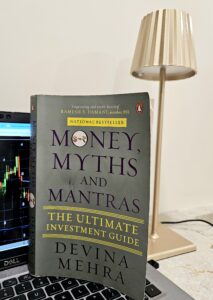I have to thank the Husband for introducing me to Devina Mehra. I had never heard of her before and I was definitely missing something.
This book resonated with me for two reasons –
1. A woman is in charge of managing the Money.
2. Sound advice, no braggadocio, addressing some topics that never really get discussed (for e.g. when to sell a stock).
And therefore two types of people should definitely read this book –
1. ALL women. Take a 360 degree view around you and identify how many women you know, are fully in control of their own money ? i.e. they operate their own bank accounts (not just lockers), they make their own decisions on buy / sell stocks, they pay their own insurance premiums and make other decisions. I know a few but not as many as I should. Financial education is a MUST-HAVE. I’m prioritizing that for my daughters and whoever else will listen basically.
2. All investors. Whether you are a seasoned investor or a rookie just starting out with their first pay check. Know this. “Paisa hi paise ko kheechta hain.” So look at investments as a critical part of creating a second income stream for yourself and not just as a ‘retirement kitty’. This book will make you passionate about your own wealth creation, which is such a good thing, no?
The thing that I liked most about the book was getting that sweet sense of validation from an expert. It does feel good when you realize that some of the decisions you made without really being the head of a big investment firm – were solid. Both my husband and I are not ‘inheritance babies’. We built ourselves up slowly over time, with prudence and common sense never leaving the discussion, even momentarily.
The thing that I did not mind so much, but other readers might not enjoy is that there are a few very technical chapters in the book. And by technical I mean formulae and the like. So either you know all of that and breeze through it – or it’s too much and you can skip it entirely – the book still has some really valuable perspectives.
Let’s get into it.
MONEY, MYTHS AND MANTRAS
~ by DEVINA MEHRA

Devina Mehra was a gold medallist both at IIM Ahmedabad and Lucknow University. On 24 August 1993, she resigned from Citibank and started her entrepreneurial journey. She is the founder, chairperson and managing director at First Global which started out as an investment banking and stockbroking business but metamorphosed into an India and global fund management outfit. In short, she is quite the rock star !
I have to say, I could not avoid thinking that Devina does have a bit of a bone to pick with Berkshire Hathaway. She calls out Warren Buffet and his company multiple times throughout the book and always in the context of busting some myths. But all her comments are 100% factual and true – there are no opinions here. Just good analysis and it makes you think about how little we look into those we admire from a distance.
“To my parents (Late) Dr Amarnath Mehra and Swaraj Mehra, who taught me to think for myself and not be afraid of having opinions, even if they did not ‘fit in’.”

THE FOUR THUMB RULES OF YOUR FINANCIAL HEALTH
“Lesson 1 : Asset Allocation sahi hai”
You should have an excel which lists all your investments and a simple pie chart of the distribution between Commodities (gold & silver), Real estate, Equity, Fixed Income, Alternatives (e.g. Art). When I was young, the advisors we had used to say that the proportion of equity should be very high as you are young and your risk appetite should be higher. It was so logical that I believed it.
“All behavior, good or bad, is always driven by incentives, and sellers of equities incentivize their salespeople far more than sellers of any other asset class, even if they do not deliver returns. That is part of the reason for this ‘100 per cent in equity if you are young’ recommendations you often see. Don’t ever forget this!”
For example, if I had put all my money in Gold in 2005 instead of Equity…
10gm Gold in 2005 was INR 7000. Today it is about INR 91000. i.e. roughly up 12x.
Nifty in 2005 was at about 2836 and is at ~23000 today i.e. less than 10x. And while I don’t have a handy chart, I’m pretty sure the volatility in the latter was significant.
“Lesson 2 : Take a portfolio approach to investing”
“Even within your equity portfolio, be mindful of the weightage of each of your stocks and each sector”
Often times I see people buying a stock because ‘yeh chadhne waala hai!’ Never once thinking about what they already have and what happens if it doesn’t really go the way they think it will.
“Lesson 3 : If there is one God in investing, it is risk management”
“If your Rs 100 becomes Rs 65 in a market fall, you need a 50+ per cent rise in the market to just come back to Rs 100!..Always first concentrate on minimizing big losses..rather than maximizing returns”.
“Lesson 4 : Diversify globally if you want to avoid SCARRS (Single Country, Single Currency, Single Asset Risks)”
“..In 1980s the US dollar was worth Rs 12.”
Let that sink in.
The book is filled with many analytical stories and while I’d love to share all of them here, it is best that your read the book so you don’t miss out on the context in which that story is told. Here are some of my personal favorites;
– “No matter how stable a business appears to you, the stock of that company can never be an evergreen stock. HUL underperformed the market and gave practically no returns for a whole decade, from 2001 to 2010..”
– “Investing in your circle of competence is like the story that all of us have heard- of looking for the keys where the light is, rather than where you have dropped them.”… in the context of just investing in stocks of companies you know and follow.
– “If you earn only your cost of capital, growth is irrelevant.”
– “It is better to be approximately right than be precisely wrong”
– “For the largest player in the market, it is nearly impossible to grow faster than the market, whereas for a new or smaller player, taking away 1 %, 2 %..from a larger player is not such a big deal.” ..in the context of always investing only in the big players that enjoy the largest market share.
– “..those who forget history are condemned to repeat it.” in the context of not learning from previous situations where bubbles burst. Take a look at EdTech companies, this is not the first time.
– “Not bullish, not bearish, be hare-ish. Because the hare is alert, it is fast, it is agile. It can run switfly, but it can also change direction quickly.” It is also the mascot for Devina’s company First Global!
In a nutshell, this book is part text book and part wisdom – both of which are investing essentials.
“In fact, investing yourself is the best way -actually the only way-to understand how the game works.”
So good luck at the markets and all my fellow women, where is your investment excel ?!

Ruta

Excellent read Ruta. Thank you will get my hands on Devina Mehra’s book.